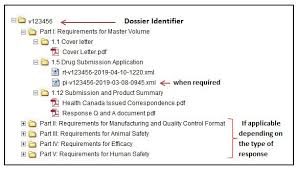Health Canada 13 may has issued guidance regarding the preparation of regulatory submissions in formats other than eCTD, instructions for electronically filing these submissions
“Health Canada has issued guidance regarding the preparation of regulatory submissions in formats other than eCTD, instructions for electronically filing these submissions.”
Health Canada issued an updated guidance on May 13, 2024, titled “Preparation of Regulatory Activities in Non-eCTD Format” for electronic submission of filings. This guidance holds significant importance for drug manufacturers and sponsors, as it provides essential instructions for the proper preparation and filing of submissions.
The objective Health Canada


The objective of the guidance document is to furnish guidance on the electronic preparation and submission of regulatory activities to Health Canada. This includes drug submissions, encompassing new drug submissions (NDS), abbreviated new drug submissions (ANDS), and supplemental new drug submissions (SNDS).
As outlined by the Canadian Food and Drugs Act (CanadaFDA), Health Canada (HC) is responsible for assessing and approving applications for clinical trials involving authorized therapeutic products. This includes reviewing and approving the use of drugs in clinical trials, as well as their sale or importation. The Institutional Ethics Committee (EC) review, mandated by the CanadaFDR and the G-CanadaCTApps, is a necessary step for each clinical trial site and can occur concurrently with HC’s review and approval of the clinical trial application (CTA). For HC’s interpretation of relevant provisions of the CanadaFDR, refer to G-FDR-0100, and for background information on HC’s assessment scope, see CAN-23 and CAN-19.
Therapeutic product
According to the CanadaFDA, a “therapeutic product” encompasses drugs or devices, or their combinations, excluding natural health products. The term “therapeutic product authorization” refers to a license permitting importation, sale, advertisement, manufacture, preparation, preservation, packaging, labeling, storage, or testing of such products. HC’s assessment scope, detailed in G-CanadaCTApps, covers clinical trials (Phases I-III) involving:
- Drugs not authorized for sale in Canada, including those in development and in comparative bioavailability studies.
- Marketed drugs proposed for a different indication, clinical use, target patient population, route of administration, or dosage regimen.
The Clinical Trial Review Process, outlined in G-CanadaCTApps and CAN-23, is coordinated by HC’s Health Products and Food Branch (HPFB). Prior to trial initiation, sponsors must submit a CTA to the appropriate HPFB Directorate: Pharmaceutical Drugs Directorate (PDD) for pharmaceuticals and Biologic and Radiopharmaceutical Drugs Directorate (BRDD) for biologics and radiopharmaceuticals. Upon receiving a CTA, the Directorate screens it for completeness. If deficiencies are identified, the sponsor receives a Request for Clarification or a Screening Rejection Letter. If the application is complete, an acknowledgment letter marks the beginning of the default 30-day review period.
Once a clinical trial is authorized, sponsors may sell or import drugs for trial use if no objections are raised within 30 days of CTA filing, as per G-CanadaCTApps. If authorized, a No Objection Letter (NOL) is issued; otherwise, a Not Satisfactory Notice (NSN) is sent. During the review period, the Directorate may request additional information, which sponsors must provide within two calendar days. Special requirements for comparative bioavailability studies and joint reviews are outlined in G-CanadaCTApps. Detailed application submission requirements can be found in the Submission Process section.
Upon issuing an NOL, HC publishes trial information in a publicly accessible database. The CanadaFDR and G-CanadaCTApps also require a Clinical Trial Application-Amendment (CTA-A) for proposed changes affecting drug quality, participant safety, or protocol risk, which must be authorized by HC before implementation. Immediate changes necessitated by participant safety may proceed without prior HC review but require subsequent notification and CTA-A filing within 15 days. HC can suspend drug authorization for trial purposes under specific circumstances, as outlined in the CanadaFDR.
Regarding regulatory fees, CAN-33 states no fees are levied for clinical trial application submission in Canada. Ethics committee approval, as per the CanadaFDR and G-CanadaCTApps, involves obtaining institutional EC (or Research Ethics Board) approval for each trial site. For research involving Health Canada or Public Health Agency of Canada, joint EC approval from HC-PHAC REB is mandatory, adhering to CanadaFDR, CA-ICH-GCPs, and HC operational policy CAN-13. The G-TCPS2 sets ethical benchmarks for Canadian ECs, primarily applicable to CIHR-, NSERC-, and SSHRC-funded institutions, as outlined in CAN-14.
This set of instructions offers comprehensive guidance on arranging and structuring submissions in the non-eCTD format. It includes directions on incorporating bookmarks, hyperlinks, and adhering to specific file naming conventions. Additionally, it delineates the distinct requirements for various submission types like NDS, ANDS, and SNDS, specifying the documents to be included and their prescribed sequence.
Health Canada mandates that corporations submit their documents electronically, utilizing either the Electronic Common Technical Document (eCTD) format or a non-eCTD format, contingent upon the nature of the regulatory activity. This guidance outlines various sections offering comprehensive details regarding these formats and additional pertinent information concerning electronic submission procedures.

